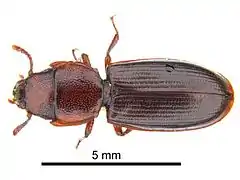| Tenebroides mauritanicus | |
|---|---|
 | |
| Scientific classification | |
| Kingdom: | |
| Phylum: | |
| Class: | |
| Order: | |
| Family: | |
| Genus: | |
| Species: | T. mauritanicus |
| Binomial name | |
| Tenebroides mauritanicus | |
| Synonyms | |
| |
Tenebroides mauritanicus, commonly known as the cadelle, is a species of beetle in the family Trogossitidae. It is a common cosmopolitan pest in storehouses and granaries.
Taxonomy and nomenclature
T. mauritanicus was first formerly described in 1758 by Linnaeus in his 10th edition of Systema Naturae,[1] who named it Tenebrio mauritanicus and classified it with the mealworm. A few decades later in 1790, the French entomologist Guillaume-Antoine Olivier proposed for it the generic name of Trogossite. For many years thereafter, the beetle was known as Trogosita mauritanica and included within the family of beetles known as the Trogositidae.
In 1783, a specimen described under the name of Tenebroides complantus [2] was recognised as Linnaeus’s original specimen of Tenebrio mauritanicus, which led to the proposal of the present name of Tenebroides mauritanicus.
The widely accepted common name cadelle is from French vernacular,[3] and in its modern meaning refers to both adults and larvae.
The specific epithet mauritanicus means Mauritanian, in reference to the species’ supposed African origin.[4][5]
The larvae were nicknamed "bargemen" by sailors because they frequently infested ships' biscuits and were noticed when they would crawl out of the biscuits and onto the "barge", a small tub used to hold biscuits on the mess table.[6]
Distribution and habitat
Having probably originated in north Africa,[4][5] the cadelle has now dispersed through human agency to most other parts of the world in exported grain products and dunnage. It probably first spread across Europe during Roman times.[5] Although primarily synanthropic, it is also found less frequently in wild habitats[7]
Identification
Resembling a carabid, the cadelle is a rather large beetle with a slightly flattened, elongate body, measuring 6 – 12 mm long. The larvae can reach up to 20 mm.[5] The body is shiny black or dark brown with reddish brown legs and antennae. The head is very large with broad temples behind almost flat eyes. The head and pronotum are coarsely punctured. There is also deep necking between the head and elytra, and the prominent sharp claws are adapted to biting.[8]
Natural history and lifecycle
A female can lay about 1000 eggs during her lifetime but will typically lay eggs in groups of about 50, loosely placed among food products. Depending on air temperature, these hatch in about 10 days.[8]
The larvae feed on various stored foodstuffs such as nuts, grain, and dried fruit. As they develop, the young begin to take live animal prey. Meanwhile, the adults are exclusively carnivorous, feeding on other insects such as Tribolium (flour beetles) and Rhyzopertha (false powderpost beetles).[5] Sometimes, adults will eat other adults of their own species.[9]
This species can go for long periods without food, over 50 days for adults and over 120 days in larvae.[8]
Pest status and control
Among the Trogossitidae, the cadelle is the only species to infest stored grain and food products.[10] Generally, the larvae only consume the soft parts of grains such as wheat and oats, so can be very destructive. Meanwhile, with their sharp claws, adults can gnaw holes in packaging to expose foods to attack from other pest species.[11] They can also bore into wood, typically pupating in the wood cavities they make.
References
- ↑ Linnaeus C. 1758. Systema naturae. 10th Edition, Holmiae, p 417.
- ↑ Piller, M, Mitterpacher, L. 1783. Iter per poseganam sclavoniae provinciam mensibus junio, et julio anno MDCCLXXXII. Typis regiae universitatis, p 87.
- ↑ Olivier GA. Encyclopédie Méthodique. Histoire Naturelle des Animaux, p243
- 1 2 Denux O, Zagatti, P. 2010. Coleoptera families other than Cerambycidae, Curculionidae sensu lato, Chrysomelidae sensu lato and Coccinelidae. Chapter 8.5. BioRisk 4 :315 - 406.
- 1 2 3 4 5 Huchet JB. 2017. Le Coléoptère, la Graine et l’Archéologue: approche archéoentomologique de quelques ravageurs des denrées stockées. M.-F. Diestch-Sellami, Ch. Hallavant, L. Bouby, B. Pradat (eds.): Plantes, produits végétaux et ravageurs. Actes des X Recontres dArchéobotanique (Les Eyzies-de-Tayac 2014). Aquitania, supplément, 36: 17 - 42.
- ↑ Macdonald, Janet (2014). Feeding Nelson's Navy: The True Story of Food at Sea in the Georgian Era. Barnsley, S. Yorkshire: Frontline Books. ISBN 978-1848327474.
- ↑ Barron JR. 1971. A revision of the Trogositidae of America north of Mexico (Coleoptera: Cleroidea). The Memoirs of the Entomological Society of Canada 103 (S75): 1 - 143.
- 1 2 3 https://www.ukbeetles.co.uk/tenebroides-mauritanicus#:~:text=A%20very%20distinctive%20species%20suggestive%20of%20a%20carabid,almost%20flat%20eyes.%20Mandibles%20prominent%20and%20produced%20forward.
- ↑ Majka CG 2011. The Trogossitidae (Coleoptera) of Atlantic Canada. Journal of the Acadian Entomological Society 7(5): 25 - 31.
- ↑ Henríquez-Valido P, Morales J, Vidal-Matutano P, Moreno-Benítez M, Marchante-Ortega Á, Rodríguez-Rodríguez A, Huchet, JB. 2020. Archaeoentomological indicators of long-term food plant storage at the Prehispanic granary of La Fortaleza (Gran Canaria, Spain). Journal of Archaeological Science 120: 105 - 179.
- ↑ Cotton, R.T. (1926). The Cadelle. Washington DC: U.S. Dept. of Agriculture. Department bulletin No. 1428.
External links
- University of Kentucky
- ZinRus Very high quality image.
See also Home stored product entomology